|
There was a time in my youth when I had no use for a handgun chambered for the .45 Colt cartridge. Back in the 1970s,
Federal Cartridge Company gave away these little pocket-size ballistics charts that listed the bullet weights and velocities for all of the cartridges that they loaded, and I always had one in my pocket. I could study it at school, and it fit nicely inside of a Sunday School book. Compared to the .357 and .44 magnums, the old forty-five was an anemic little sister to these powerful cartridges. Everybody with any sense knew that a cartridge had to have "Magnum" stamped on it to do any good at all.
Later on, some courageous handloaders began to load heavier charges into the old forty-five for stronger handguns like the
Ruger Blackhawk. Custom gunsmiths like John Linebaugh even began building five-shot cylinders for the Ruger and
El Dorado frames to increase wall thickness, thus allowing even more power from the old forty-five. Suddenly, it seemed that the .45 Colt had taken on a new life, even separate from its surge in popularity due to the sport of Cowboy Action Shooting. While the Cowboy shooters were loading it down, hunters were loading up the forty-five to magnum velocities with heavy bullets.
The great thing about the .45 Colt in modern cases as compared to the .44 Magnum is that the .45 Colt can be loaded to more power with less pressure than the .44 magnum. That is not a misprint. The .45 Colt properly loaded is more powerful than the .44 magnum. The .44 Magnum is still a great cartridge, but it takes much more pressure to push a 325-grain bullet to the speed of a 325-grain bullet in the .45 Colt. I must stress that these heavy-loaded forty-fives are not for guns such as the
Smith & Wesson N-frames or Colt Single actions or their copies. These guns are very good, but cannot handle a steady diet of 325 grain bullets pushed in excess of 1300 feet per second as can the stronger Ruger revolvers.
The .45 Ruger cylinder is at least eighty percent as strong as the .44 magnum Ruger cylinder, and the frames are the same. The .45 Colt cartridge can be loaded safely to 32,000 psi pressure in the Ruger single action, and even to higher pressures in the Ruger Redhawk.
Hodgdon Powder Company has some very good load data on their website for the heavy .45 Colt cartridge, listing both velocity and pressure for every load. The success of the heavy forty-five is based upon using heavy bullets at magnum velocities. Trying to push lightweight bullets to around two thousand feet per second is not the way to go. For a hard-hitting load, use heavy bullets at speeds of between 1000 and 1350 feet per second. I like hard cast flat point bullets for this type of load, such as those offered by
Cast Performance Bullet
Company. These bullets have a wide flat nose for maximum impact, with enough weight to penetrate deeply through meat and
bone.
The proper powders for pushing these heavy bullets to high velocities are the slowest pistol powders such as 4227, 2400, and
Accurate Number 9. However, the best powders that I have found for this purpose are
Winchester 296 and Hodgdon 110, with possibly the very best being
Hodgdon LilíGun. These powders can safely push 300 and 325 grain bullets in excess of 1300 feet per second. I like magnum primers with these powders. All modern .45 Colt cases are made of good brass, but I prefer
Starline to all others for heavy .45 Colt
loads.
Shooting these heavy loads in the Ruger Blackhawk can get painful due to the shape of the gunís grip frame. While I love the feel of the standard Blackhawk grip, it is not the most comfortable with heavy bullets at high velocities. Ruger solved this problem for most shooters in 1985 with the introduction of the Ruger Bisley revolver. The Bisley uses the same frame as Rugerís Blackhawk and Super Blackhawk, but with a greatly modified grip frame that was designed by
Larry Larson, with obvious influence from the famous Keith Number Five grip
frame.
The Ruger Bisley grip is much more comfortable for handling repeated firings of heavily recoiling loads in a single action revolver. The custom gunsmiths who build the powerful five shot forty-fives use the Ruger Bisley grip frame almost exclusively. The shape and length of the Ruger Bisley grip helps to keep the revolver from excessively rolling upward in the shooterís hand upon firing. The Bisley hammer is easier to reach than that of the Blackhawk, and the trigger has a more comfortable
shape.
The Ruger Bisley .45 Colt is available in blued finish with adjustable sights and a seven and one-half inch barrel. Ruger offers the
Bisley Vaquero with fixed sights, but for these heavy loads, I greatly prefer the versatility and shape of the adjustable sights. The Bisley as an unfluted roll-engraved cylinder on all current production models. Some earlier guns were shipped with fluted cylinders. The test gun pictured here weighed in at 48.8 ounces and had a trigger pull of four and three-quarters of a pound. After a quick
"Poor Boyís Trigger Job", the trigger pull measured a crisp two pounds and fourteen ounces. Ruger has offered limited production runs of the .45 Colt Bisley in stainless steel, one of which is pictured here. It has a five and one-half inch barrel, and weighs in at 46.8 ounces. It has been outfitted with a pair of
Eagle Gripsí American Elkhorn grip panels. I also installed a new number five locking base pin from
Belt Mountain, which greatly improved the tightness of the action, and eliminated all perceptible side play in the cylinder. The Ruger Bisley is a rugged and durable sixgun that can withstand a steady diet of heavy .45 Colt loads, and does not punish the shooter while doing
so.
I tested the Ruger Bisley with a variety of ammunition, both standard loads, and some heavy "Ruger Only" loads as listed on the Hodgdon website. Accuracy at twenty-five yards was very good with all loads tested, even the light 200 grain round nose bullets bought in bulk for plinking. The test gun would group just about every handload into less than three inches at twenty-five yards, and would group its favorite loads into the same size at fifty yards.
For those shooters who do not handload, the same heavy .45 Colt performance can be had in factory-loaded ammunition from either
Cor-Bon or Buffalo Bore. I tested two different loads from Buffalo Bore of their "Heavy .45" ammunition, and three different loads from Cor-Bon of their ".45 Colt +P" ammo. All of these are for modern, strong revolvers and lever action rifles.
Do not use this ammo in older, weaker designs. If in doubt, ask the manufacturer of the ammunition. The chronograph results are listed in feet per second for the factory ammo as follows:
| LOAD |
Velocity 7-1/2" Barrel |
Velocity 5-1/2" Barrel |
| Buffalo Bore 325 grain Cast |
1411 |
1328 |
| Buffalo Bore 260 grain Jacketed
Hollowpoint |
1553 |
1455 |
| Cor-Bon 300 grain Jacketed Soft Point |
1336 |
1297 |
| Cor-Bon 335 grain Cast |
1082 |
1044 |
| Cor-Bon 265 grain Bonded Hollowpoint |
1444 |
1369 |
All of the factory ammo tested was extremely consistent and as accurate as any of my handloads. This ammo outperforms the best .44 magnum ammunition, and makes a bigger hole as a bonus. The Ruger handled this high performance ammunition easily. There were absolutely no signs of excessive pressure, and the cases fell easily from the chambers without the slightest indication of sticking. If I could for some reason no longer load my own ammunition, I would be perfectly happy using this high quality factory fodder. The 260 grain Buffalo Bore load should be perfect for deer, and their 325 grain load would be suitable for even large bears. For a load offering very good penetration with much less recoil, the Cor-Bon 335 grain load would be an excellent choice.
The Ruger Bisley in .45 Colt is in a very unique position among revolvers. It is plenty accurate for hunting. It is relatively light weight for its strength. The grip is well-suited to handle magnum recoil. It has more power than a .44 magnum, while having less muzzle blast and noise, and finally, it is a true bargain among firearms today. There are custom and semi-custom revolvers available that offer even more power from the .45 Colt, but at a much higher price. For an easily-affordable off-the-shelf sixgun that is suitable for just about any game animal on Earth, there is nothing better than the Ruger Bisley in .45 Colt, properly loaded.
Check out the complete line of Ruger firearms here.
You can order the locking base pin directly from Belt Mountain at:
www.beltmountain.com.
For load data on the heavy .45 Colt, go to: www.hodgdon.com.
For high performance .45 Colt ammunition go to: www.buffalobore.com
and www.cor-bon.com.
For the finest in hard cast LBT style bullets, go to:
www.castperformance.com.
The holster rig pictured is El Paso Saddlery's "Duke" rig, available online from:
www.epsaddlery.com.
Jeff Quinn
|
For a list of dealers where you can
buy this gun, go to: |
|

|
  
Got something to say about this article? Want to agree (or
disagree) with it? Click the following link to go to the GUNBlast Feedback Page.
|
|
Click pictures for a larger version.
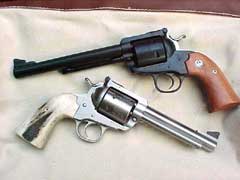
7-1/2" blue steel Ruger Bisley (top) and
5-1/2" stainless Ruger Bisley fitted with Eagle Grips
American Elkhorn grip panels (bottom).

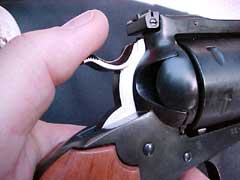
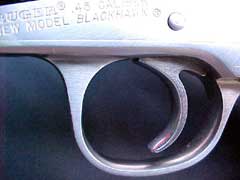
The Ruger Bisley design features a reshaped hammer,
allowing easy thumb reach, and a more curved trigger shape.

Current Bisleys feature unfluted, roll-engraved
cylinders.
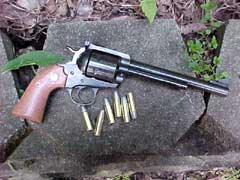
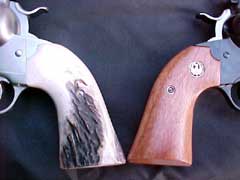
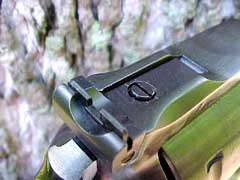
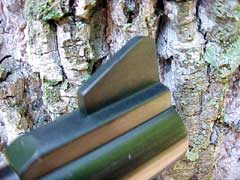
Fully adjustable rear sight and target-style front sight
make the Ruger suitable for target shooting, plinking or
hunting with a wide variety of loads.
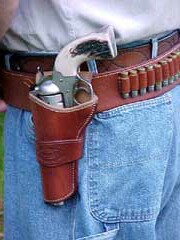
The Ruger Bisley .45 is right at home in El Paso
Saddlery's "Duke" rig.
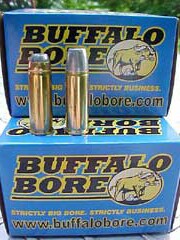
Left to right: Buffalo Bore's 260grain JHP and 325-grain
hard cast lead bullet loads.
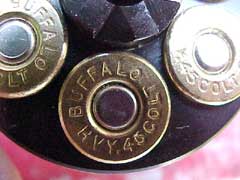
Buffalo Bore heavy .45 Colt loads are headstamped to
eliminate confusion. You don't want to fire these heavy loads
in older, weaker guns!

Left-right: Cor-Bon's 300-grain JSP, 335-grain hard cast
lead, and 265-grain JHP loads.
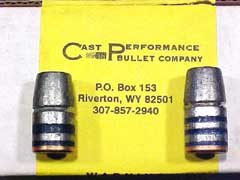
Cast Performance heat treated LBT style bullets are the
author's favorites for heavy loads in the .45 Colt Ruger
Bisley. Shown on the left is the 335 grain with the 360 grain
on the right.
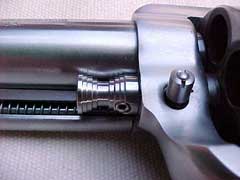
Belt Mountain's #5-style locking base pin. Their base
pins help increase the accuracy and reliability of SA sixguns.
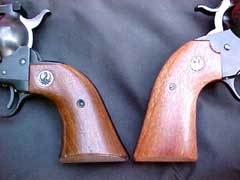
Ruger's standard Blackhawk grip frame (left) as compared
to Ruger's Bisley grip frame (right). For more information,
read Bill Hamm's
article on Ruger SA grip frames.
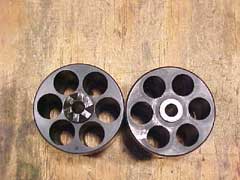
Comparison of cylinders: Ruger .45 Bisley (left) and .44
Magnum Super Blackhawk (right). While the .44 leaves
noticeably more "beef" between chambers, the .45 has
the strength required for heavy loads.
|
![]()